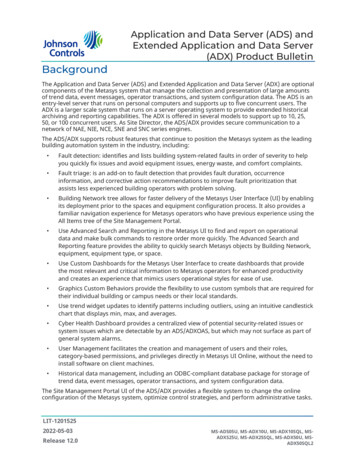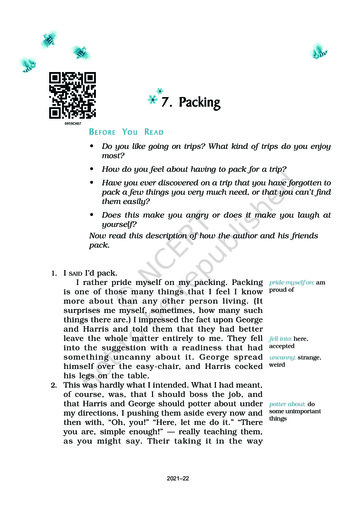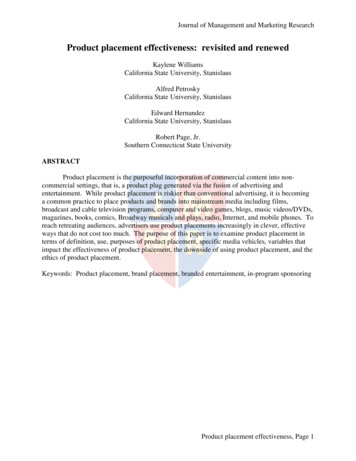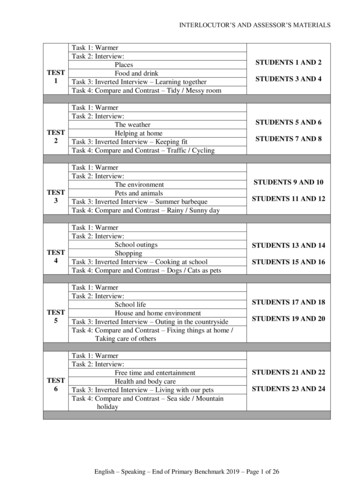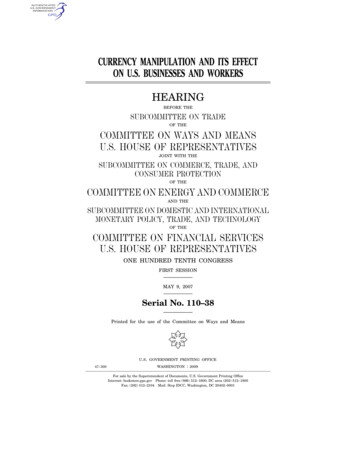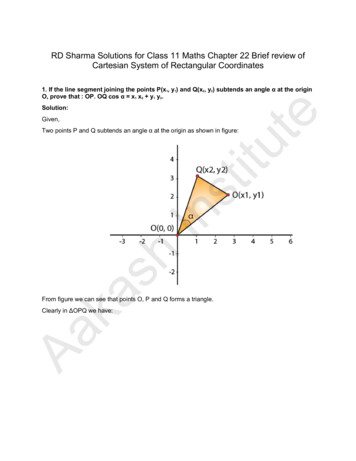
Transcription
RD Sharma Solutions for Class 11 Maths Chapter 22 Brief review ofCartesian System of Rectangular Coordinates1. If the line segment joining the points P(x1, y1) and Q(x2, y2) subtends an angle α at the originO, prove that : OP. OQ cos α x1 x2 y1 y2.uteSolution:Given,kashInstitTwo points P and Q subtends an angle α at the origin as shown in figure:From figure we can see that points O, P and Q forms a triangle.AaClearly in ΔOPQ we have:
utetitInssh2. The vertices of a triangle ABC are A(0, 0), B (2, -1) and C (9, 0). Find cos B.kaSolution:Given:The coordinates of triangle.AaFrom the figure,
utetitBy using cosine formula,kashInsIn ΔABC, we have:Aa3. Four points A (6, 3), B (-3, 5), C (4, -2) and D (x, 3x) are given in such a way that, find x.Solution:
utetitInsshkaAa24.5 28x – 1428x 38.5x 38.5/28 1.3754. The points A (2, 0), B (9, 1), C (11, 6) and D (4, 4) are the vertices of a quadrilateral ABCD.Determine whether ABCD is a rhombus or not.
Solution:Given:InstituteThe coordinates of 4 points that form a quadrilateral is shown in the below figureshNow by using distance formula, we have:kaIt is clear that, AB BC [quad ABCD does not have all 4 sides equal.] ABCD is not a RhombusEXERCISE 22.2 PAGE NO: 22.181. Find the locus of a point equidistant from the point (2, 4) and the y-axis.AaSolution:Let P (h, k) be any point on the locus and let A (2, 4) and B (0, k).Then, PA PBPA2 PB2
utetitSolution:Ins2. Find the equation of the locus of a point which moves such that the ratio of its distancefrom (2, 0) and (1, 3) is 5: 4.Let P (h, k) be any point on the locus and let A (2, 0) and B (1, 3).So then, PA/ BP 5/4AakashPA2 BP2 25/16
ute3. A point moves as so that the difference of its distances from (ae, 0) and (-ae, 0) is 2a, provethat the equation to its locus is, where b2 a2 (e2 – 1).Solution:titLet P (h, k) be any point on the locus and let A (ae, 0) and B (-ae, 0).AakashInsWhere, PA – PB 2aNow again let us square on both the sides we get,(eh a)2 (h ae)2 (k – 0)2e2h2 a2 2aeh h2 a2e2 2aeh k2h2 (e2 – 1) – k2 a2 (e2 – 1)
Now let us replace (h, k) with (x, y)uteThe locus of a point such that the difference of its distances from (ae, 0) and (-ae, 0) is 2a.Where b2 a2 (e2 – 1)Hence proved.4. Find the locus of a point such that the sum of its distances from (0, 2) and (0, -2) is 6.titSolution:AakashWhere, PA – PB 6InsLet P (h, k) be any point on the locus and let A (0, 2) and B (0, -2).
5. Find the locus of a point which is equidistant from (1, 3) and x-axis.Solution:Let P (h, k) be any point on the locus and let A (1, 3) and B (h, 0).InstituteWhere, PA PBSolution:sh6. Find the locus of a point which moves such that its distance from the origin is three timesis distance from x-axis.Let P (h, k) be any point on the locus and let A (0, 0) and B (h, 0).AakaWhere, PA 3PBNow by squaring on both the sides we get,h2 k2 9k2h2 8k2By replacing (h, k) with (x, y) The locus of point is x2 8y2EXERCISE 22.3 PAGE NO: 22.21
1. What does the equation (x – a) 2 (y – b) 2 r2 become when the axes are transferred toparallel axes through the point (a-c, b)?Solution:Given:The equation, (x – a) 2 (y – b) 2 r2((x a – c) – a)2 ((y – b ) – b)2 r2(x – c)2 y2 r2x2 c2 – 2cx y2 r2x2 y2 -2cx r2 – c2titHence, the transformed equation is x2 y2 -2cx r2 – c2uteThe given equation (x – a)2 (y – b)2 r2 can be transformed into the new equation by changing x byx – a c and y by y – b, i.e. substitution of x by x a and y by y b.2. What does the equation (a – b) (x2 y2) – 2abx 0 become if the origin is shifted to thepoint (ab / (a-b), 0) without rotation?InsSolution:Given:The equation (a – b) (x2 y2) – 2abx 0AakashThe given equation (a – b) (x2 y2) – 2abx 0 can be transformed into new equation by changing xby [X ab / (a-b)] and y by Y3. Find what the following equations become when the origin is shifted to the point (1, 1)?(i) x2 xy – 3x – y 2 0(ii) x2 – y2 – 2x 2y 0
(iii) xy – x – y 1 0(iv) xy – y2 – x y 0Solution:(i) x2 xy – 3x – y 2 0Firstly let us substitute the value of x by x 1 and y by y 1Then,ute(x 1)2 (x 1) (y 1) – 3(x 1) – (y 1) 2 0x2 1 2x xy x y 1 – 3x – 3 – y – 1 2 0Upon simplification we get, The transformed equation is x2 xy 0.(ii) x2 – y2 – 2x 2y 0titx2 xy 0Then,InsLet us substitute the value of x by x 1 and y by y 1(x 1)2 – (y 1)2 – 2(x 1) 2(y 1) 0x2 1 2x – y2 – 1 – 2y – 2x – 2 2y 2 0Upon simplification we get,x2 – y2 0sh The transformed equation is x2 – y2 0.(iii) xy – x – y 1 0Let us substitute the value of x by x 1 and y by y 1Then,ka(x 1) (y 1) – (x 1) – (y 1) 1 0xy x y 1 – x – 1 – y – 1 1 0Upon simplification we get,Aaxy 0 The transformed equation is xy 0.(iv) xy – y2 – x y 0Let us substitute the value of x by x 1 and y by y 1Then,(x 1) (y 1) – (y 1)2 – (x 1) (y 1) 0xy x y 1 – y2 – 1 – 2y – x – 1 y 1 0Upon simplification we get,
xy – y2 0 The transformed equation is xy – y2 0.4. At what point the origin be shifted so that the equation x2 xy – 3x 2 0 does not containany first-degree term and constant term?Solution:The equation x2 xy – 3x 2 0We know that the origin has been shifted from (0, 0) to (p, q)uteGiven:So any arbitrary point (x, y) will also be converted as (x p, y q).The new equation is:Upon simplification,x2 p2 2px xy py qx pq – 3x – 3p 2 0tit(x p)2 (x p)(y q) – 3(x p) 2 0Insx2 xy x(2p q – 3) y(q – 1) p2 pq – 3p – q 2 0For no first degree term, we have 2p q – 3 0 and p – 1 0, andFor no constant term we have p2 pq – 3p – q 2 0.By solving these simultaneous equations we have p 1 and q 1 from first equation.The values p 1 and q 1 satisfies p2 pq – 3p – q 2 0.shHence, the point to which origin must be shifted is (p, q) (1, 1).5. Verify that the area of the triangle with vertices (2, 3), (5, 7) and (-3 -1) remains invariantunder the translation of axes when the origin is shifted to the point (-1, 3).Solution:kaGiven:The points (2, 3), (5, 7), and (-3, -1).The area of triangle with vertices (x1, y1), (x2, y2), and (x3, y3) is ½ [x1(y2 – y3) x2(y3 -y1) x3(y1 – y2)]AaThe area of given triangle ½ [2(7 1) 5(-1-3) – 3(3-7)] ½ [16 – 20 12] ½ [8] 4Origin shifted to point (-1, 3), the new coordinates of the triangle are (3, 0), (6, 4), and (-2, -4)obtained from subtracting a point (-1, 3).The new area of triangle ½ [3(4-(-4)) 6(-4-0) – 2(0-4)] ½ [24-24 8]
½ [8] 4Since the area of the triangle before and after the translation after shifting of origin remains same,i.e. 4.AakashInstitute We can say that the area of a triangle is invariant to shifting of origin.
1. What does the equation (x - a) 2 (y - b) 2 r2 become when the axes are transferred to parallel axes through the point (a-c, b)? Solution: Given: The equation, (x - a) 2 (y - b) 2 r2 The given equation (x - a)2 (y - b)2 r2 can be transformed into the new equation by changing x by x - a c and y by y - b, i.e. substitution of x by x a and y by y b.


